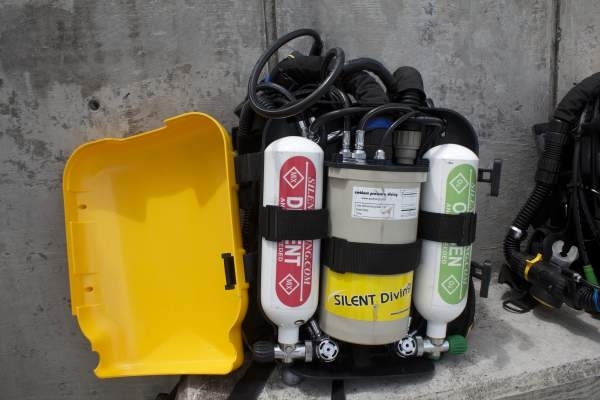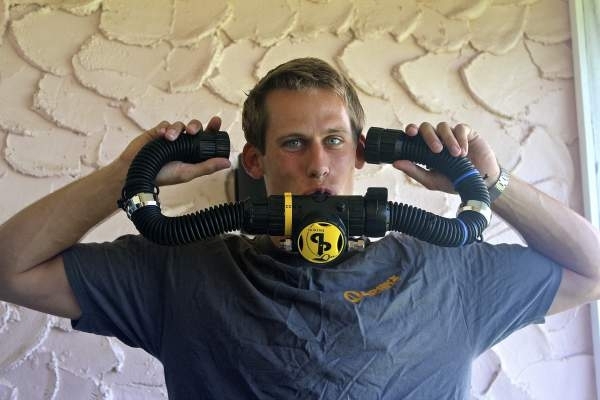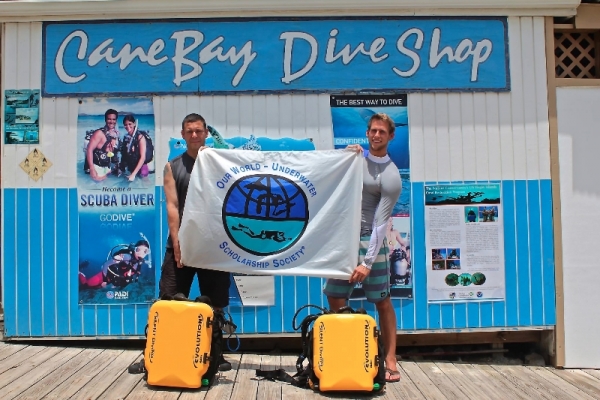Last March at the Beneath the Sea Dive Show, I met Mike Fowler, President of a company called Silent Diving. Silent Diving sells three different types of rebreathers: the Inspiration, the Evolution and the Evolution +. A rebreather is a piece of scuba equipment that is able to recirculate the diver’s breath by scrubbing out the CO2 and adding oxygen to a loop. Instead of open circuit scuba where you inhale from a tank and exhale bubbles into the water column, a rebreather contains the diver’s breath all within that loop. This means no bubbles!
Another added advantage of diving a rebreather is increased bottom time. There are two tanks mounted within the unit, one pure oxygen tank and the other is a dilutant (in our case, regular air). Two computers constantly monitor the oxygen partial pressure (ppO2) and control the mixing of the two gasses so that the optimal oxygen percentage is constantly achieved. A third computer displays the information and tracks the decompression for the dive. For instance, a diver at 130 ft. would be breathing a 26% nitrox mixture and when ascending to 90 ft., the diver would be breathing a 35% nitrox mixture (all based on a ppO2 set point of 1.3). Pretty cool right?! Click here if you want to learn more about them (yes, I did just use Wikipedia as a source. Sorry to all of my writing professors, I have failed you).
Mike invited me out to do my training on the island of St. Croix, one of the US Virgin Islands. A week of diving in the warm, turquoise blue, crystal clear waters of the Caribbean… it was a tough choice. Up until that point, the majority of my diving had been done in a 7mm wetsuit with 20 to 30 foot visibility (on a really good day) so I jumped at the chance to descend onto coral reef formations in a rash guard and trunks (don’t get me wrong, I still love cold water diving).
I will admit that I had been carrying around a misconception about rebreathers. They take a long time to set up, to break down, to maintain and that all of that extra trouble won’t be worth it. And they are downright dangerous. I couldn’t have been more wrong. It was actually a fairly quick set up and break down, not taking much longer than diving open circuit. One of the things that Mike first told us was that his purpose was to train divers to think. I spent over 10 hours underwater during the week and practiced the skills necessary to deal with an emergency situation. I feel confident in my skills and in the training that Mike provided.
The week was fantastic with gray reef shark encounters on almost every dive, sea turtles, squid, and colorful fish maneuvering between enormous sponges and intricate coral. Without bubbles, we were able to take part in their world. No longer fleeing at first sight, their curiosity invited them to come closer and interact with these odd beings. I’m excited to continue my training in the future and am working out the details to complete my closed circuit rebreather (CCR) cave course with Mike at some point during my scholarship year!
There are a few people that deserve a huge thank you for making this training happen. Mike, of course, for his time and for letting me borrow an Evolution to train on. Norm Gustafson and CQuest for fills and logistical support. Cane Bay Dive Shop for allowing us to use their facilities and for fills as well. And my dive buddies, Barb Kilgour and Linda Lait, who are now rebreather certified as well!
Follow along on my adventure by subscribing to the blog and by following me on instagram! Also, you can learn a little bit more about me in my Bio section. More to come soon about my time in St. Croix working with leatherback turtles!




